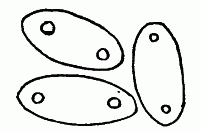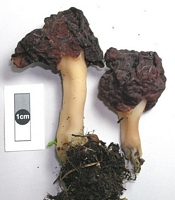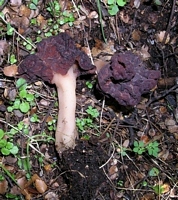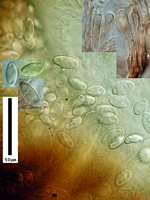|
 Gyromitra tasmanica Gyromitra tasmanica
SynonymsHelvella tasmanica
BiostatusPresent in region - Indigenous. Non endemic
Images (click to enlarge)
Caption: Fig. 1. Spores of Gyromitra tasmanica, Cooke from the type collection. (Enlarged by 750 times.) | 
Owner: J.A. Cooper | 
Owner: J.A. Cooper | 
Caption: spores and paraphyses.
Owner: J.A. Cooper | |
Article: Raitviir, A. (1965). Taxonomical notes on the genus Gyromitra. Eesti NSV Teaduste Akadeemia Toimetised, Bioloogiline Seeria 14: 320-324.
Description: Fruitbodies 4-6 cm high. Pileus 2-3 cm in diameter, irregularly hemispherical,
undulate, with brown hymenium, free margins and whitish underside. Stipe stout,
cylindrical, 2-3 x 0.3-1 cm, smooth. whitish. Asci subcylindrical, 200-250 x 11-14 µ.
Spores uniseriate, ellipsoid or elongated ellipsoid, smooth, hyaline, with two small oil
drops at each end. 21-26 x (9.7)-10-13 µ. Paraphyses cylindrical, clavately enlarged and
dark brown at apices.
Distribution: Distribution: Tasmania, New Zealand.
Notes: There is also a good species of Gyromitra from the southern hemisphere. Examining
collections of Helvella, loaned from the Herbarium, Royal Botanic Gardens Kew, my
attention was called by a specimen labelled Helvella monachella from New Zealand.
Macroscopically it already had the appearance of a Gyromitra. which was proved by
microscopical analysis. In search for a name for this fungus, I made my decision in
favour of Gyromitra tasmanica Cooke.
It is a good species of Gyromitra from the southern hemisphere, close to G. esculenta,
but differing in poorly developed pileus with entirely free margins and in larger and
more elongated spores. The specimen from New Zealand agrees well with Cooke's figure
in external characters, and there are no differences in spores of this collection and type.
either. It must be noted that the spores of this species are figured in Mycographia
incorrectly. They are typically ellipsoid or elongated ellipsoid, but never fusoid (fig. 1).
Dr. Dennis described them as ellipticfusoid (Dennis in Lit.). but there seems to be a
difference in the Terminology.
|